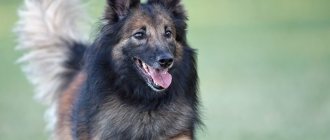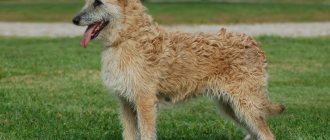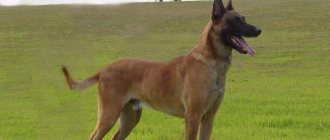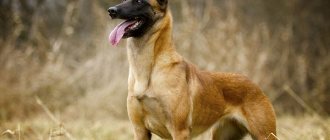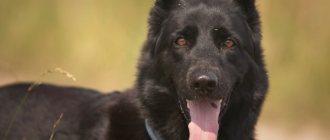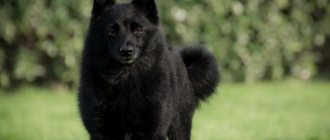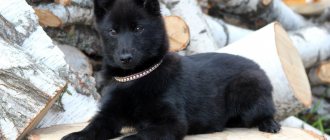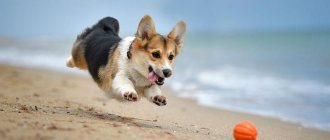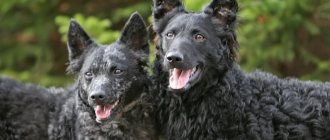| Origin: | Belgium |
| Usage: | Herding, guard, companion dog |
| Color: | Black |
| Dimensions: | Weight up to 9 kg, height at withers 20-23 cm |
| Lifespan: | up to 15 years |
Schipperke (schipperke) - the smallest shepherd dogs bred in Belgium, belong to the group of herding dogs. The funny appearance of the dog will not leave anyone indifferent to its person. Behind the plush toy appearance lies the character of a real shepherd. The Schipperke dog breed is popular in European countries and the USA. In our country it has not yet received wide recognition and popularity. Many people, seeing a photo of a Schipperke dog, confuse it with a simple mongrel.
Pros and cons of Schipperke
When choosing a Schipperke pet for yourself, it is worth considering all the pros and cons of the pet. The undoubted advantages include:
- Compact sizes. A dog can easily live both in a small city apartment and in a large country house.
- Excellent security qualities and an innate love for catching rats. The pet is fearless and reports all suspicious incidents with a loud bark.
- Devotion to the owner, whom the animal will follow anywhere if properly raised.
- Intelligence and intelligence, for which they are valued in rescue services.
The disadvantages include:
- How much does a Schipperke cost? A purebred puppy will cost at least $1,280, and show-class pets are even more expensive.
- A large amount of time will be required to devote to the pet for games, walks and training.
Character
In its playfulness, loyalty and friendly disposition, the Schipperke is similar to dog breeds such as the Pomeranian and German Spitz. But one cannot call him irresponsible; he has a harmonious sense of duty (security, watchdog qualities) and a love for various entertainments.
The little dog, of course, will not be able to cope with the robber on his own, but he will be able to warn his owners about the arrival of uninvited guests with a loud bark. He always treats strangers with distrust and watches their actions warily. Noticing a threat in the movements of a stranger, the Schipperke will immediately rush to protect the owner and all household members. Able to bite in a dangerous situation.
Representatives of the breed get along with children from their family, but with insufficient education they can react poorly to other people's children and their pranks.
Curiosity and activity are integral features of the Schipperke. This nimble dog seemingly never sits still for a minute. He constantly studies the territory and is interested in the world around him. It reacts to any moving object with a loud bark and raised scruff. This is not surprising, because the instinct of a rodent hunter has been in full swing in this dog since birth. Rest assured that there will not be a single mouse or rat in the territory under the Schipper’s control.
Representatives of the Belgian breed get along well with other pets. Schipperke is able to establish friendly relations even with a cat. But conflicts often arise with a dog of the same sex, which is explained by the struggle for leadership. It is not recommended to keep guinea pigs, ferrets, rats and other rodents in the same house as a Schipperke; a dog with a hunting instinct may mistake them for prey.
Are Schipperkes only black?
According to the standard of the International Cynological Federation FCI, only one color is recognized for the Schipperke - black. Even small white spots and hairs are a defect. However, at the dawn of its formation in the breed, one could meet dogs of other solid colors: fawn, blue, chocolate. Since 1920, they have been allowed by the British Kennel Club standard on a par with black ones, although they are quite rare in the breed. Most often you can see fawn British Schipperkes with shades ranging from wheat to golden. The American Kennel Club AKC standard also recognizes only black dogs, while the American UKC organization allows the breeding of Schipperkes and other solid colors (fawn, chocolate, blue, red, white). It is worth noting that two-color dogs, for example, black and tan, and diluted colors - blue and fawn, are not recognized by any organizations.
History of the breed
Schipperke means "little captain" in Flemish. The name arose in the second half of the nineteenth century. It is believed that it was invented by English-speaking sailors. The Schipperke was highly valued by water transport owners as it was ideal for fighting rats and mice.
The origin of the breed dates back to the seventeenth century. The homeland of the Schipperke is Belgium. The ancestors are small ancient dogs with black coat color, their name is “Leuvenar”. Representatives of the breed were extremely popular in the nineties of the seventeenth century among shoemakers and ordinary workers. Competitions were held between Schipperke owners to see which dog had the most original collar. Typically, collars were made of copper and decorated with all sorts of intricate additions.
Initially, the purpose of energetic black dogs was to protect property and catch rodent pests. In the nineteenth century the situation changed. The breed standard was approved and a breeding club was founded. Schipperke began to take part in exhibition shows, gaining popularity not only in their homeland, but also in America and European countries.
Where did this breed come from, what did these dogs do?
A small active dog weighing 10-12 kg was widespread in the 16th-17th centuries in Belgium. Working people selected larger specimens for herding sheep (the ancestors of today's Belgian Shepherds), and smaller ones for guarding their yards, and also as rat catchers. From the latter came the Schipperke. Large breweries kept them to kill rats and mice. The Schipperke was also used as a herding dog, especially for driving geese to market. Thus, at the beginning of the 19th century, the Schipperke was practically the only known breed of domestic (yard) dog in Belgium until 1880.
Brief history of origin
The birthplace of the breed is Belgium, and the first mention of it dates back to the 17th century. Although Schipperkes are similar in appearance to Spitz dogs, there is no genetic connection between them. The closest relatives of these dogs are the Belgian Shepherds and the now extinct Leuvenards, which were bred in the province of Brabant in the 15th century.
Schipperkes quickly gained a reputation as unsurpassed mousecatchers and became popular among Belgians suffering from rodent infestations. During the flood of the Seine, hordes of rats attacked residential buildings. They almost completely destroyed food supplies and, in order to protect the pantries, the townspeople began to have dogs capable of catching rodents.
In 1882, Queen Henrietta Maria showed interest in Schipperke. Succumbing to the charm of dogs, she bought herself a puppy, which prompted the court nobility to acquire the same animals. In 1887, Schipperke came to Great Britain. And a little later they learned about the breed in the USA.
In 1888, the Belgian Schipperke breeding club began to function, and the breed itself was standardized. At first, the dogs had a heterogeneous appearance and breeders had to separate individuals from Louvain, Antwerp and Brussels. Subsequently, the breed was unified and now the Schipperke is recognized by all leading cynological associations, including the FCI.
Color
- A distinctive feature of the Schipperke is its jet-black coat color. Puppies at an early age may have some white guard hairs, but at the first molt these hairs are replaced by black ones.
- In England you can find the Schipperke with golden fur. But this color was developed thanks to Schipperke's breeding experiments with white Geeshonds.
- In the USA you can see these brown dogs. The coat has a beautiful chocolate color, but such individuals are rare.
- The bluish-gray color of this breed is absolutely rare. These puppies have dark pigmentation on their ears, paws, and back. The nose is the same bluish tint.
- The only variants are the black and tan Schipperke. The dog is black in color, but there are cream spots on the chest, paws, belly and eyebrows.
Care
Caring for a Schipperke is not difficult, and a beginner can easily handle this task.
Particular attention will need to be paid only to the pet’s hair and the preparation of the diet.
In addition to combing the fur, grooming includes the following procedures:
- examining and cleaning your pet's ears and eyes;
- bathing;
- brushing your teeth
Grooming
Caring for the Schipperke's coat involves brushing, which should be done 2-3 times a week. Ignoring this procedure will lead to the formation of tangles. First, using a medium-tooth comb, you need to comb your pet, moving the tool from head to tail, and then smooth the hair with a special mitten.
Schipperkes shed 3 times a year, but can lose their fur due to stress. In females, additional molting begins after birth. The undercoat grows over several months. During shedding, brushing must be done daily. To remove undercoat, use a slicker brush. It is necessary to accustom your pet to this procedure from puppyhood so that it does not cause him stress in the future.
It is recommended to bathe your pet no more than 2 times a year without using any shampoos. You cannot dry your hair with a hairdryer. Show dogs should be washed as needed, using a specialized shampoo for black wool, which will help hide the “rust” (the tips of the Schipperke’s hairs fade in the sun and become reddish).
It is recommended to brush your teeth regularly using a special brush and toothpaste. For a beginner, this procedure may cause some difficulties, in which case it is better to consult a veterinarian.
Schipperkes are prone to developing ophthalmic diseases, so their eyes should be given special attention. In addition to regular inspection for the presence of dirt and removal of secretions using a cotton pad dipped in warm water, you will need to take your pet for preventive examinations to the veterinarian once every six months.
It is recommended to inspect the ears regularly and clean accumulated dirt as necessary. To carry out the procedure, you should use a cotton pad soaked in a special lotion, which can be purchased at a veterinary pharmacy.
Feeding
In the first 2 weeks after purchasing a puppy from a nursery, it is recommended to feed it with the food that the breeders gave it. After this time, you can switch your pet to natural food or industrial food of at least premium class (Acana, Royal Canin, Brit). It is not advisable to mix these types of food.
It is recommended to feed an adult dog no more than 2 times a day. If the owner has decided to give the Schipper only natural food, then you should first familiarize yourself with the list of prohibited and permitted foods and dishes.
Table. Permitted and prohibited products
| Allowed | Prohibited |
| Meat (beef, poultry, rabbit) | Pork and smoked meats |
| Sea and river fish, cleaned of bones and fins | Bones (can only be used to make broth) |
| Fresh eggs | Bakery, pasta and confectionery products |
| Dairy products (kefir, cottage cheese) | Milk |
| Porridge on the water | Porridge made from whole oatmeal and pearl barley |
| Greenery | Spices |
| Fresh vegetables | Pickled foods and pickles |
Sea fish must be passed through a meat grinder, and river fish must be boiled. Meat can be given raw, but in this case it must be frozen in the freezer for 2-3 days or scalded with boiling water.
For any type of feeding, the dog should always have a bowl of filtered water freely available. With a natural type of nutrition, it is recommended to include mineral supplements in the Schipperke’s diet. It is advisable to consult a veterinarian regarding the appropriate complex and its dosage.
Dog care
Schipperkes are quite clean, so caring for them will not be very burdensome.
The main attention is to the wool. You will have to comb it 2-3 times a week, and during the molting period - daily.
The rest of the procedures are standard:
- The ears are examined and cleaned with a cotton swab moistened with boiled water once a week. You can use special veterinary lotions.
- Eyes are cleansed daily with boiled water, chamomile infusion or tea leaves.
- Teeth are brushed twice a week with a special brush and paste for veterinary use. The dog is also given dental treats. All together helps to avoid the appearance of tartar.
- The paw pads are examined at least once a week, and the nails are trimmed as needed with a special nail clipper.
- Bathing should be rare - 2-3 times a year. After a walk, it is enough to rinse only your pet’s paws with water without detergents (or wipe them with a damp cloth).
It is recommended to keep the Schipperke in the house or on the veranda of a private house. The dog will feel uncomfortable in the enclosure or in the yard; it loves people too much. In addition, due to its innate curiosity, the breed is prone to escape. Any hole in the fence will lead the pet to this idea, and in the enclosure she can simply dig a hole to freedom.
You need to walk your dog not so often, but actively. But it is not recommended to let her off the leash in crowded places; she may rush at other people or chase other people’s dogs or cats. If you take your pet to classes, say agility, 2-3 times a week, then on other days two walks of an hour each time will be enough.
Schipperke nutrition
Schipperkes are unpretentious not only in care, but also in food. This dog will not be capricious while waiting for something tastier. Its diet may be monotonous, but it must be balanced and meet the needs of an energetic dog.
It is enough to feed an adult dog (over a year old) once a day. Puppies are fed more often depending on their age (from 6 to 2 times a day).
The basis of nutrition is meat (beef, rabbit, turkey, chicken). Twice a week, meat can be replaced with boiled sea fish without bones. The diet also includes:
- eggs;
- cottage cheese;
- porridge from various cereals with vegetables and herbs;
- dairy products (for example, milk porridge, kefir).
Natural nutrition is always supplemented with vitamin complexes. Here it is better to consult a veterinarian who will recommend a specific drug.
Schipperkes will also eat commercially prepared food with no less pleasure. You just need to choose it correctly. For such an energetic dog, it is better to choose super premium or holistic food, specifically designed for active pets, for example:
- Royal Canin HE Club;
- Chicopee Pro Nature Line Active;
- Acana Heritage Sport & Agility;
- Purina PRO PLAN Large Adult Athletic;
- Monge Dog Specialty Active.
When feeding on industrial feed, there is no need to add vitamin-mineral complexes to the diet.
Advantages and disadvantages
The greatest positive quality of Schipperke dogs is their unpretentiousness in maintenance and excellent health. They do not need comfort, and can live in an enclosure thanks to their dense, thick undercoat.
The dogs learn quickly and are owner-oriented. Belonging to the working category, the breed needs to realize its natural qualities, and if they are provided to it, then one cannot ask for a better companion.
Sometimes the disadvantages include the cost of Schipperke puppies, the price of which is commensurate with the price of an old car. But the greatest disadvantage of the breed is the need to communicate with the owner, especially during the formation of the dog’s psychological stability at the age of 3-15 weeks.
Lack of communication leads to the suppression of the breed's character traits inherent in nature. Such dogs are poorly socialized, do not want to learn, and are vicious.
An unrealized Schipperke is capable of fighting with all pets and people living under the same roof with him, aggressively greets guests, and provokes conflict situations during a walk.
Character and behavior
The Schipperke is an affectionate and friendly dog that quickly gets used to people. She is infinitely devoted to her master and his family members. A sociable dog does not tolerate separation from its owner and a change of place of residence.
Schipperke is wary of strangers, but happily welcomes guests who often visit the owner's house. The dog has well-developed guard instincts and can be used as a guard.
The Schipperke never loses vigilance and instantly reacts to suspicious noises. Although the dog loves to bark, if trained correctly, it will not bark over trifles.
Breed and children
Schipperkes have a favorable attitude towards the owner's children and are patient with their pranks. True, dogs do not ask for friendship and prefer to watch children from afar. If the kids become too intrusive, the Schipperke simply retreat to another room.
On a note. Young or poorly raised Schipperkes may be aggressive towards unfamiliar children.
Breed and other animals
Schipperke easily gets along with his relatives and cats. But when keeping several same-sex dogs together, you need to be prepared that they will compete for territory. True, this fight usually does not go beyond grumbling and lightly biting the opponent.
Important! The Schipperke has a highly developed sense of ownership, which often develops into pathological greed. Dogs are not ready to share their toys or food with other animals.
The Schipperke wages an irreconcilable fight against decorative rodents, which is not surprising, given the original purpose of the breed.
Breed characteristics
The description of the Schipperke is somewhat similar to the description of Spitz, which is not a dwarf decorative breed. However, herding dogs also have their differences. Outwardly, they are quite attractive, quite harmoniously built and characterized by a triple layer of black wool, which is why these animals are not afraid of the cold. Their fur coat is quite warm, fluffy and thick. Dogs have differences based on gender. Based on this, they have different heights and weights, and there are also differences in body proportions.
In males it averages 32–33 cm, the height of females does not exceed 31 cm. The head of the snipper is not long, but rather wide, its shape is wedge-shaped. The forehead is broad, the upper lines of the muzzle and skull are parallel. The Schipperke's muzzle is shorter than the skull and usually does not exceed half the length of the head. The type of muzzle is compact, neat, it tapers towards the nose, the lips of the representative of the breed are dense, the cheeks and cheekbones are full.
The eyes of these dogs are almond-shaped, their irises are brown in color, and their size is relatively small. They are planted shallowly, do not have a convexity, and their outline is always dark. The ears of the Schipperke are small, their position is vertical, they are erect.
The nose is small and always black. The cheekbones and brow ridges are somewhat convex, but moderately developed, they are clean and blend smoothly into the muzzle. The bite in dogs is regular, scissor-shaped, but can also be straight; the standard allows for incomplete fullness. For example, an individual representative of the breed may lack a third or second molar. In some dogs, the incomplete formula consists of the absence of first premolars. The teeth themselves are quite strong and are well positioned in the jaws.
The Schipperke's chest is lowered to the elbows, the body is proportional, although to some it may seem wide and stocky. The physique tends to be square, the neck is strong and powerful, muscular. Due to the voluminous wool collar, it appears thick, its top line is slightly curved.
The withers of the Schipperke are expressive, and due to the dense mane, they are especially noticeable in males. The back is straight, powerful, the loin is strong, the croup is wide, its rear part is rounded. The lower line of the body is lowered from the front of the chest to the elbows and raised towards the stomach. The stomach itself is not saggy or sunken.
The dog has a high tail. When the animal is calm, it can reach the hocks and also hang down with a slightly curved end. When the dog moves, it rises to the top line (usually no higher). And also the standard does not prohibit it from being twisted or thrown over the back. Sometimes puppies of this breed are born tailless or may have a vestigial (shortened) tail.
The standard does not limit this feature and allows dogs with three types of tails for exhibitions. However, in a number of European countries docking is prohibited, so it is unacceptable to bring a dog without a tail to such an event. According to the regulated standard established by the Fédération Cynologique Internationale, the color of dogs must be exclusively black. In England it can be golden; in America, colors such as chocolate, bluish and black and tan are allowed.
As for the limbs, they are parallel, the length of the front ones from the ground to the elbows is comparable to half the height of the animal at the withers. The hind legs are located under the body and appear wide due to the feathering. They are somewhat longer than the front ones and have short but strong claws. The skin of animals is smooth, the skin fits tightly over the body. The coat of the smallest shepherd is characterized by an abundance of guard hairs. They are straight, rough, thick and feel dry to the touch.
Choosing a puppy
Schipperke litters are few in number - a female rarely gives birth to more than four puppies. When choosing a baby, the appearance of the puppy is of great importance:
- shiny fluffy coat without dandruff and bald patches;
- clean ears and genitals;
- clear eyes;
- high level of activity;
- fatness without excess body weight, a bloated abdomen, which may indicate the presence of worms in the intestines;
- confidence in movements;
- no lameness.
Schipperke puppies develop quickly, and at 45-50 days of age they are ready to move literally immediately after activation
The first thing people pay attention to when choosing a baby is the head, the fullness of the muzzle, the fit and length of the ears. By the age of one month, ears usually begin to stand up
The puppy's format should be square.
The puppy must have documentary support - a birth certificate and a veterinary passport with vaccination dates. If a puppy is adopted at the age of five weeks, then it should already have two vaccinations. Puppies receive the third childhood vaccination at three months of age, if teeth have not begun to change by this time. If the moment is missed, the dog is vaccinated immediately after changing teeth, at the age of 5-6 months.
When purchasing a puppy, you need to get a full consultation from the breeder about feeding rules and the timing of the pet’s next worming.
Care and conditions of detention
Schipperke is clean, so caring for him does not take much time. Due to its overall dimensions, this dog can be kept in an apartment or in a house. But an outdoor booth is quite suitable for him; the animal is not afraid of the cold. It is necessary to take into account the working potential of the dog. The Schipperke needs long walks and active exercise.
How to train to a litter box and to go out for a walk
It is better to teach your puppy to go to the toilet outside from an early age. While the pet is small and has not received vaccinations, you can train it to the tray. Select a specific place and cover it with a diaper. After each meal, after sleep, take your pet to the tray and hold it until it does its job. The Schipperke is a smart dog, and when the puppy’s body can physiologically control the urge, he will run to the toilet or ask to go outside.
Feeding puppies and adult dogs
The breed is unpretentious in food. Diversity is not necessary at all. The main thing is the balance of nutrients. When eating natural foods, the menu should include a lot of meat (turkey, veal, beef), offal, vegetables, and cereals. 2-3 times a week you can give your Schipperka sea fish, boiled eggs, and fermented milk products. Porridge can be cooked in milk. It is recommended to add 1 spoon of vegetable oil and herbs (if they are cooked in water) to the porridge.
When feeding your dog naturally, you also need to include vitamin and mineral complexes. It is better to consult a veterinarian about this. If a feeding system in the form of industrial feed was chosen, then no additional bait is required. It is better to choose super premium food designed for active dogs.
Place to sleep
Thanks to the warm undercoat, the Schipperke can live not only in an apartment, but also in an enclosure in a private area. He loves fresh air very much and is not afraid of cold weather. It must be taken into account that the dog is very sociable and is afraid of loneliness. Living on the street, she will not receive the attention she needs. Therefore, it is better to arrange a sleeping place for your pet indoors, so that from there he can observe everything that the owners are doing. The main thing is that the dog is not damp and there are no drafts.
Hygiene
The Schipperke has a thick coat and needs regular brushing (2-3 times a week). The animal sheds three times a year. During this period, you need to comb it daily.
Schipperke dogs are not groomed or trimmed.
In addition to grooming, regular eye and ear examinations are required. Soured eyes are wiped with a cotton pad soaked in chamomile infusion or a special lotion. Cleaning the ears is done with a sponge soaked in warm water or antiseptic.
You need to brush your dog's teeth 2 times a week. To prevent the formation of tartar, it is recommended to give your dog dental treats. Nails need to be trimmed as they grow. Although more often they wear down on their own due to the constant mobility of the dog.
Walks
Short walks twice a day are not suitable for the Schipperke. Spending a long time in a closed space at home is not for him. If you don’t have time for long walks, you can shorten them, but only if they are filled with intense sports.
Important! The dog must be taken out on a leash. The hunter's instincts inherent in the Schipperke will lead to the dog starting to run in the street after all the animals and bark at passers-by
Vaccinations
The vaccination procedure is identical for all dogs. The first vaccination of the Schipperke should be done in the nursery at 1.5-2 months. Revaccination is done after 3-4 weeks. At 6-8 months, in addition to the complex vaccine, an anti-rabies drug is administered. After vaccination at 12 months, annual prophylaxis is given with complex vaccines (Dipentavak, Nobivak).
10-12 days before the procedure, the puppy needs to be dewormed with special anthelmintic drugs. The vaccine will not be effective if the dog has worms. It is recommended to carry out helminth prevention 3-4 times a year.
Toys
When a Schipperke is bored, he directs his energy in the wrong direction. The dog often barks, fights with other animals in the house, and attacks guests. Therefore, he needs to be provided with a variety of games: frisbee, agility, obedience. At a time when the dog is not busy with the owner, he can play with toys, of which there should be a lot. These can be balls, ropes, soft toys (durable and without small parts).
Training and education
In appearance, the Schipperke is a sweet, affectionate animal, but in reality he is quite capricious, brave, and often shows stubbornness. Therefore, such a dog needs an owner with a strong character who can raise an obedient, adequate, disciplined pet from the puppy.
Training for the Schipperk is also necessary, as for the Swiss or Australian Shepherd. These species are similar in character and have excellent protective abilities.
Early socialization is the main rule in the educational process of representatives of the breed. The Schipperke loves to bark loudly; in the absence of socialization and training, such an active dog will bark at all passers-by, the same reaction occurs when the doorbell rings or just extraneous sounds. It is important to teach your pet to react adequately to surrounding events.
Thanks to his intelligence, excellent memory and sharp mind, training the Schipperke is not very difficult. The main thing is to learn to cope with his stubbornness. For this purpose, consistency of training, game form of lessons, and variety are recommended.
Interesting Facts
- In Flemish, schipperke means “little captain” or “little boatman”; there is also a version of the translation - “shepherd boy”.
- Dog trainer Florimond Verbank says that in the old Brabant dialect, schipperke means “small sheepdog.”
- In their homeland (Belgium), Schipperke are affectionately called little skippers.
- Until 4-5 years old, the Schipperke behaves like a small playful puppy; this does not prevent him from being a fearless guard.
How to choose and where to buy a Schipperke puppy
The puppy's parents must have documents, and he must have:
- puppy card;
- veterinary passport containing vaccination records;
- brand.
When choosing a baby, you need to pay attention to his behavior. Puppies exhibiting extreme behavior can cause a lot of problems for the owner.
It is better to choose the “golden mean”: the baby should be playful, curious, aggressive towards his brothers, but everything should be in moderation.
The Schipperke's temperament is inherited, so it is advisable to observe the puppy's parents from the outside. It is also undesirable to adopt a dog with health problems. It is unknown how long she will live, but a lot of money will have to be spent on his treatment.
When choosing a Schipperke puppy you need to pay attention to:
- For the dog's health. The puppy must be moderately well-fed, have clean eyes, ears and genitals. The coat should have a healthy shine, without dandruff and bald patches. The baby must move confidently; lameness is unacceptable.
- On body proportions. The puppy's bone proportions will not change with age, so you need to ensure that the dog meets the requirements of the standard. The puppy should be square.
- On the tail. Puppies may be born without a tail at all or with an incomplete tail. This is the norm and is not a marriage. If a puppy was born with a tail, then there should be no kinks on it (they become visually noticeable by the age of one month).
- For wool. You can determine the color of the undercoat by the color of the heels. With light colors it will be gray, with dark colors it will be black.
A Schipperke puppy can be adopted at the age of one and a half months. By this age, he is already ready to move to a new home.
A Schipperke puppy should only be purchased from a professional nursery.
You can buy Schipperke puppies in the following nurseries:
- Moscow, nursery “WINTERRA”, https://www.hasski.ru/.
- Moscow, nursery “Akulova Gora”, https://akulovagora.ru/.
The price of puppies starts from $700.
How to choose a pet
A Schipperke puppy costs an average of 50-70 thousand rubles, so it is safer to go to certified nurseries for it. At the stage of choosing a future pet, it is advisable to ask:
- the presence of a mark and metrics;
- behavioral characteristics;
- living conditions for mothers and babies;
- health status of parents and puppies.
To understand what shade of undercoat a Schipperke puppy will have when he grows up, you need to pay attention to the color of his paw pads. If they are light, then the underfur will be grayish, if they are dark, it will be black.
On a note. If a Schipperke puppy has a tail of natural length, it is better to feel it for thickening and kinks. If such defects are discovered, it is worth considering another applicant.
Description of the breed
The Schipperke is a well-built, small dog. Males differ from females in size and proportions. The average height of an adult is from 25 to 33 cm. For the standard, the size of the dog is not particularly important, and the following characteristics play an important role:
- Weight. An acceptable weight is considered to be from 3 to 9 kg, and the optimal range is 4–7 kg.
- Back length. This indicator should be equal to the height at the withers.
- Dog muzzle. It should be shorter than the skull and occupy less than 1/2 of the length of the head.
Breed standard:
- The body is square. The neck is short, the chest is strong, and the withers are developed. The groin should be tightened.
- The head is shortened and wedge-shaped.
- The eyes are almond-shaped and small. The color of the iris is brown.
- The ears are small, pointed at the tips.
- The limbs are strong. The hind legs are slightly longer than the front legs.
The Schipperke has no tail from birth and is usually docked short. Dogs have no folds on their skin, and it is pigmented black. Dense undercoat is softer than wool. It provides reliable protection from moisture and wind. The black fur grows densely. The hairs on the ears, limbs and muzzle are shorter. The longest hair is in the area of the mane, frill and “panties” (hind and forelimbs above the elbows).
Breed description, standards, appearance
The Schipperke is a small, stocky dog with a wide body and graceful limbs. According to the international classification, it belongs to the section of shepherd dogs without testing working qualities.
Size and constitution
The Schipperke is a medium-sized breed and grows between 26-35 cm at the withers and weighs 3-9 kg. The female looks shorter and lighter than the male.
According to the FCI breed standard No. 83 of 2010, a typical Schipperke must meet the following description:
- The head is wedge-shaped with a developed skull, a relatively short muzzle, moderately convex eyebrows, well defined cheekbones and a prominent stop. The nose is small with a black nose. The jaws are strong, covered with black, tightly fitting lips. Teeth are healthy, white, complete. Scissor or pincer bite.
- The eyes are small, almond-shaped with black eyelids and dark brown irises. The look is lively and mischievous.
- The ears are miniature, triangular, mobile, erect with a durable linen and pointed tips.
- The body is square in format with a strong, muscular neck, a straight, strong topline and a wide, horizontal croup. The chest is wide and deep with well sprung ribs. The hemline is moderately tucked.
- The limbs are straight and parallel with fine bones, small, rounded paws, curved toes and strong, black claws. Movement is flexible, free with good propulsion.
- The tail is set high, reaching to the hocks. When moving, it can rise to the line of the back. A tail curled or carried above the top line is not considered a fault. Some Schipperkes are born bobtailed, with a vestigial or short tail.
According to the breed standard, serious exterior faults include:
- poorly pigmented eyelids, lips and nose;
- hanging or semi-erect ears;
- lack of teeth;
- snack or undershot;
- lack of breed type;
- narrow, rounded or convex skull;
- cryptorchidism (in males).
Color and coat type
The Schipperke has an abundant, thick, straight and fairly rigid spine and a rich, soft down. Short hair grows on the head, ears, metatarsals, hocks and the front surface of the forelimbs. The body and tail of the dog are covered with a tightly fitting awn of medium length. The Schipperke has well-developed decorative hair, forming characteristic “pants”, “collar” and “jabot”.
Important! The Schipperke is not allowed to have a long, soft spine with no down. A thin, wavy, fluffy coat with underdeveloped decorative hair is considered a fault.
The Schipperke has only one color option - black. According to the standard, a dog has a grayish undercoat, provided that it is not visible under the guard hair. It is acceptable for older representatives of the breed to have gray hair.
Choosing a puppy
Although Schipperkes are quite popular in Europe, this breed is still rare in Russia. The dogs are bred in one kennel, “Schipperke,” which is located in the Moscow region. But it is possible that there are also private individuals involved in breeding dogs of this breed.
In order not to make a mistake in your choice, you need to check the documents for the baby you are purchasing. He must have a pedigree or a puppy card, on the basis of which a pedigree is drawn up in the club. Try to see the puppy’s parents and evaluate their behavior.
A Schipperke puppy is expensive, so you need to make sure it has a pedigree
The small number of this breed affects the cost of puppies. Thus, a pet-class baby (not suitable for exhibitions and breeding) can be purchased from 30,000 rubles. A breed-class puppy will cost 40–60,000 rubles, and for a show-class baby you will have to pay from 70,000 rubles.
How much do Schipperke puppies cost?
The Schipperke dog breed is considered rare in Russia, and the price for them is higher than for other dogs. In professional nurseries the price will be higher than in pet stores or through private advertisements.
Schipperke pet class puppy: the price for such a baby ranges from 10 to 20 thousand rubles. A pet from this category is not intended for mating and participation in exhibitions; it has minor deviations from the breed standard, which in no way affect its quality of life.
Breeding class puppy: Schipperke dog, whose future is breeding and has a good pedigree. Its price ranges from 20 to 45 thousand rubles.
Show-class Schipperke puppies: intended for participation in exhibitions and demonstration performances. Such a puppy can cost from 70 thousand rubles and more. For those wishing to purchase an elite puppy, it does not matter how much such a baby costs.
Where to keep a pet
Due to its small size, this dog gets along well in an apartment. But their warm undercoat and long hair allow them to live in enclosures in private homes. These animals feel good in the fresh air in our not particularly harsh winters.
Pet care
The description of the key criteria for caring for the Schipperke includes actions that are no different from the rules for caring for other breeds. There are only a few clarifications due to their peculiarities.
Bathing
The dog must be washed as soon as it gets dirty. You shouldn't do this too often. Most bathing occurs during the molting period. Long hair needs to be dried after washing to protect your pet from this procedure - use dry shampoos. They perfectly remove dirt from the coat without moisturizing it too much.
Combing wool
The animal's luxurious fur must be combed once a week, and during the molting period - twice a day. Combing should be done with a brush with hard bristles.
Important! After shedding, the dog changes noticeably and its fur becomes very sparse. But this phenomenon is temporary
In 2 months she will again have magnificent hair.
Cleaning teeth, ears, eyes
Regular examination of the animal's teeth, ears and eyes will protect it from various types of diseases.
Your pet's teeth should be examined every week and plaque should be removed as needed. Wipe your eyes and ears after every walk. The structure of the inside of the ears helps trap dirt in them. This threatens the appearance of parasites in this part of the body.
Physical activity for a faithful friend
Schipperkes are very energetic and active dogs. They must be constantly on the move, otherwise it will affect not only their physical health, but also their psychological health, causing an increase in aggression. Keeping an animal in a private home helps solve this problem. Without your participation, the dog can jump to his heart's content in the yard or in the enclosure.
A representative of this breed living in an apartment is recommended to be walked at least 2 times a day, accompanied by active games and jogging.
What to feed your dog
These animals are not picky when it comes to food. This breed only needs one feeding and a small snack at night. But this should not suggest a large portion. The amount of food is regulated by the owner, focusing on the weight and age of the dog. Schipperkes should not be overfed - they are prone to obesity and epilepsy attacks against this background.
Feeding the puppies
It is recommended that puppies eat a varied diet, with regular intake of vitamin D and a complex of minerals. You need to feed in small portions, and the number of feedings depends on the age of the puppy:
- 1-2 months - 6 times;
- 2-3 months - 4 times;
- 3-6 months - 3 times.
Proper and healthy nutrition is the key to health and excellent appearance. The dog requires a special diet and only high-quality food. This is the only way to ensure her strong immunity and longevity. Pedigree food is a representative of the economy class, that is, with a fairly good composition, its price is affordable.
His diet should include:
- porridge;
- fresh meat - preferably beef;
- dairy derivatives - cottage cheese, kefir;
- fish (after 5 months);
- vegetables and fruits.
Diet for an adult Schipperke
It is recommended to feed an adult animal with premium dry food or natural food.
Homemade food is prepared taking into account the physical condition and taste preferences of the dog:
- if the dog does not want to eat boiled vegetables, give him raw ones;
- if he likes fresh milk, prepare milk porridge;
- give lean meat;
- cottage cheese.
Do not give dogs food from the owner's table. The diet of an adult dog is the same as that of a small puppy.
Did you know? Foods that serve as treats for humans are poisonous for dogs. So, one and a half bars of chocolate is a lethal dose for a small dog. Theobromine contained in it causes severe tachycardia in dogs, turning into convulsions.
You cannot give:
- uncrushed oatmeal and pearl barley porridge;
- pasta;
- White bread;
- pork;
- smoked meats;
- bones.
Oso de Miel Schipperke Nursery
01/18/22
Oso De Miel Gloria - Champion of Estonia!!!
8-916-587-86-01 |
01/16/22
Congratulations to our graduate Oso de Miel Yaxley (n\b)!!! Congratulations to our graduate Oso de Miel Yaksli (n\b) !!!
01/11/22
Congratulations to Oso de Miel Luigi Vampa on another title!!! Congratulations to Oso de Miel Luigi Wampa with another title!!!
01/06/22
Congratulations to our Champion on yet another title!!!
04.12.22
Congratulations to our Champion on yet another title!!!
12/30/21
Congratulations to Oso de Miel Zhar-Ogon on winning another title!!!
12/18/21
Exhibition MKOO "DOGSVILLE" Expert - PETER FIRIC (SERBIA). Oso de Miel Luigi Vampa (n/b) - BOS, CAC, BOB!!! Congratulations to the owners.
12/18/21 Exhibition MKOO “DOGSVILL” Expert – PETER FIRIK (SERBIA). Oso de Miel Luigi Vampa (n\b) - BOS, CAC, BOB !!! Congratulations to the owners.
12/01/2021
Oso De Miel Gloria Narva Dog Show 27-28.11.21 2 x SERT, 2 x TP, BIG 4 New Champion Estonia Judges: Rade Dakic (Serbia) and Kornelija Butrimova (Lithuania).
November 27, 2021
Congratulations to Jana Obžerová (Czech Republic) and Oso de Miel Santa Muerte on winning the title Czech Champion!!! Congratulations to Jana Obžerová (Czech Republic) and Oso de Miel Santa Muerte on closing the title of Champion of the Czech Republic !!!
October 28, 2021
Oso de Miel Walking around Moscow (n\b) received a diploma of OKD-1 degree. Oso de Miel Shagay ro Moscow (n\b) received an OKD-1 degree diploma.
03.11.2021
Oso de Miel Irish Dark - New Russian Champion!!! Oso de Miel Irish Dark — New Champion of Russia!!!
October 28, 2021
Oso de Miel Walking around Moscow (n\b) successfully demonstrated the presence of a shepherd instinct. Oso de Miel Shagayu po Moscow (n/b) has successfully demonstrated the shepherd instinct.
September 21, 2021
Oso de Miel Yusipeka (n\b) successfully demonstrated the presence of a shepherd instinct. Oso de Miel Yusipeka (n/b) has successfully demonstrated the shepherd instinct.
18.10.2021
Oso de Mielka and her friends)))
14.10.2021
The first day in the new house and the first team.
September 25, 2021
Judge - Nina Janger Finland BOS-puppy Oso de Miel Enur
